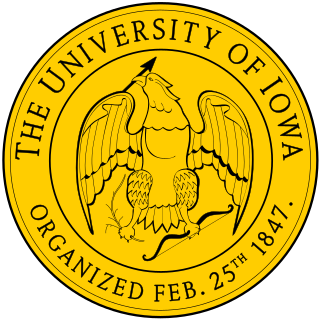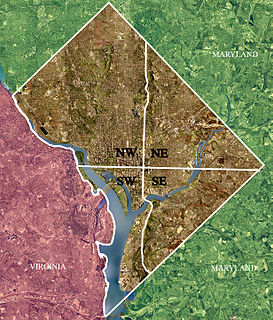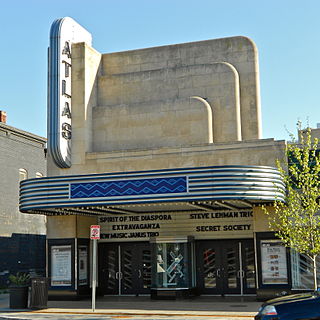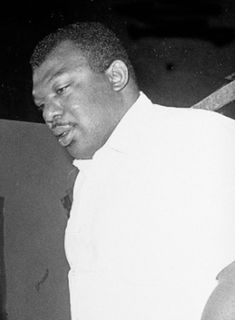
The Smithsonian Institution, or simply the Smithsonian, is a group of museums and education and research centers, the largest such complex in the world, created by the U.S. government "for the increase and diffusion of knowledge". Founded on August 10, 1846, it operates as a trust instrumentality and is not formally a part of any of the three branches of the federal government. The institution is named after its founding donor, British scientist James Smithson. It was originally organized as the United States National Museum, but that name ceased to exist administratively in 1967.

Washington, D.C., formally the District of Columbia, also known as just Washington or simply D.C., is the capital city and federal district of the United States. It is located on the east bank of the Potomac River, which forms its southwestern and southern border with the U.S. state of Virginia, and it shares a land border with the U.S. state of Maryland on its remaining sides. The city was named for George Washington, a Founding Father and the first president of the United States, and the federal district is named after Columbia, a female personification of the nation. As the seat of the U.S. federal government and several international organizations, the city is an important world political capital. It is one of the most visited cities in the U.S. with over 20 million visitors as of 2016.

Lincoln Center for the Performing Arts is a 16.3-acre (6.6-hectare) complex of buildings in the Lincoln Square neighborhood on the Upper West Side of Manhattan. It has thirty indoor and outdoor facilities and is host to 5 million visitors annually. It houses internationally renowned performing arts organizations including the New York Philharmonic, the Metropolitan Opera, the New York City Ballet, and the Juilliard School of Music.

The University of Iowa is a public research university in Iowa City, Iowa, United States. Founded in 1847, it is the oldest and largest university in the state. The University of Iowa is organized into 12 colleges offering more than 200 areas of study and seven professional degrees.

David Hamilton Koch was an American businessman, political activist, philanthropist, and chemical engineer. In 1970, he joined the family business: Koch Industries, the second largest privately held company in the United States. He became president of the subsidiary Koch Engineering in 1979, and became a co-owner of Koch Industries in 1983. Koch served as an executive vice president of Koch Industries until he retired due to health issues in 2018.

The Anacostia Community Museum is a community museum in the Anacostia neighborhood of Washington, D.C., in the United States. It is one of twenty museums under the umbrella of the Smithsonian Institution and was the first federally funded community museum in the United States. The museum, founded in 1967, was created with the intention to bring aspects of the Smithsonian museums, located on the National Mall, to the Anacostia neighborhood, with the hope that community members from the neighborhood would visit the main Smithsonian museums. It became federally funded in 1970 and focuses on the community in and around Anacostia in its exhibitions. This museum also houses a library.

Anacostia is a historic neighborhood in Southeast Washington, D.C. Its downtown is located at the intersection of Good Hope Road and Martin Luther King Jr. Avenue. It is located east of the Anacostia River, after which the neighborhood is named.

The Anacostia River is a river in the Mid Atlantic region of the United States. It flows from Prince George's County in Maryland into Washington, D.C., where it joins with the Washington Channel to empty into the Potomac River at Buzzard Point. It is about 8.7 miles (14.0 km) long. The name "Anacostia" derives from the area's early history as Nacotchtank, a settlement of Necostan or Anacostan Native Americans on the banks of the Anacostia River.

Southwest is the southwestern quadrant of Washington, D.C., the capital of the United States, and is located south of the National Mall and west of South Capitol Street. It is the smallest quadrant of the city, and contains a small number of named neighborhoods and districts, including Bellevue, Southwest Federal Center, the Southwest Waterfront, Buzzard Point, and the military installation known as Joint Base Anacostia–Bolling.

Cooper Hewitt, Smithsonian Design Museum is a design museum housed within the Andrew Carnegie Mansion in Manhattan, New York City, along the Upper East Side's Museum Mile. It is one of 19 museums that fall under the wing of the Smithsonian Institution and is one of three Smithsonian facilities located in New York City, the other two being the National Museum of the American Indian's George Gustav Heye Center in Bowling Green and the Archives of American Art New York Research Center in the Flatiron District. It is the only museum in the United States devoted to historical and contemporary design. Its collections and exhibitions explore approximately 240 years of design aesthetic and creativity.

Near Northeast is a neighborhood in Northeast Washington, D.C. It is bounded by North Capitol Street to the west, Florida Avenue to the north, F Street to the south, and 15th Street to the east.

The Mahaffey Theater – Duke Energy Center for the Performing Arts is a performing arts facility and concert hall located on the downtown waterfront in St. Petersburg, Florida. The facility first opened on May 6, 1965.The 2,031-seat facility features European box-style seating, a ballroom space and views of Tampa Bay.

The Joyce Theater is a 472-seat dance performance venue located in the Chelsea neighborhood of New York City. The building opened in 1941 as the Elgin Theater, a movie house, and was gut-renovated and reconfigured in 1981-82 to reopen as the Joyce Theater. The Joyce is a leading presenter of dance in New York City and nationally.

The Atlas Performing Arts Center is a multiple space performing arts facility located on H Street in the Near Northeast neighborhood of Washington, DC. Housed in a renovated Art Deco movie house, the facility is home to several arts organizations.
The performing arts in Detroit include orchestra, live music, and theater, with more than a dozen performing arts venues. The stages and old time film palaces are generally located along Woodward Avenue, the city's central thoroughfare, in the Downtown, Midtown, and New Center areas. Some additional venues are located in neighborhood areas of the city. Many of the city's significant historic theaters have been revitalized.

New York City Center is a 2,257-seat Moorish Revival theater at 131 West 55th Street between Sixth and Seventh Avenues in Midtown Manhattan, New York City, one block south of Carnegie Hall. City Center is a performing home for several major dance companies as well as the Encores! musical theater series and the Fall for Dance Festival. The center is currently headed by Arlene Shuler, a former ballet dancer who has been president since 2003. The facility houses the 2,257 seat main stage, two smaller theaters, four studios and a 12-story office tower.
John Jacob Zink (1886–1952) was an American architect who designed movie houses in Washington, D.C., and Baltimore.

Uncle Beazley is a life-size fiberglass statue of a triceratops by Louis Paul Jonas. It is located near Lemur Island in the National Zoological Park in Northwest Washington, D.C.

John Robert Edward Kinard was an American social activist, pastor, and museum director. He is best known as the director of the Anacostia Museum, a small community museum founded by the Smithsonian Institution in 1967. Kinard was the museum's first director, and remained in the post until his death. The Washington Post said Kinard was "a passionate believer in the idea that the well-being of black people depends on having a record of their past". Noted British archeologist and museologist Sir Kenneth Hudson said Kinard "developed the Anacostia Museum into one of the small number of museums of influence in the world."

James E. Mayo (1936-1995) was an American exhibition specialist. He held this role at the Anacostia Community Museum, where he also was co-director.



















